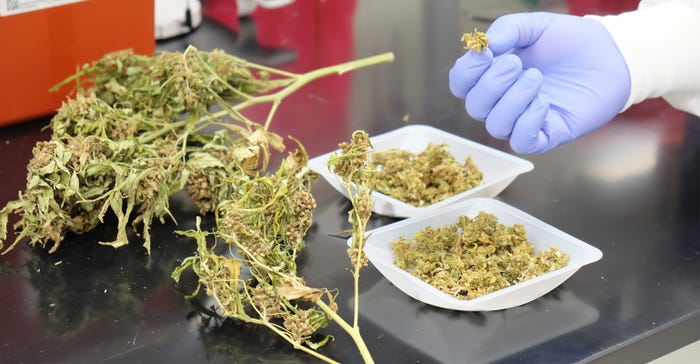September 11, 2020

A pair of studies at Kansas State University is bringing new insight to farmers and producers seeking to incorporate industrial hemp in cattle feed.
After the 2018 Farm Bill legalized hemp production in the U.S., interest has grown in industrial hemp as an agricultural commodity, including as feed for animals. FDA approval, however, through the Association of American Feed Control Officials, would be required before hemp could be fed to livestock or pets.
"Although hemp can be legally cultivated under license in Kansas, feeding hemp products to livestock remains prohibited because the potential for cannabinoid drug residues to accumulate in meat and milk has not been studied," says Hans Coetzee, professor and head of the anatomy and physiology department in the College of Veterinary Medicine.
A team of K-State researchers recently received a $200,000 Agriculture and Food Research Initiative Competitive Grant from the U.S. Department of Agriculture's National Institute of Food and Agriculture to establish concentrations of cannabinoids in livestock after exposure to industrial hemp.
"Industrial hemp is typically grown to produce oil, seed, fiber and medicines," says Michael Kleinhenz, assistant professor of beef production medicine. "While varieties of hemp may be planted for a single or dual purpose, such as for seed and fiber, byproducts consisting of leaves, fodder and residual plant fibers remain after harvest. These byproducts could serve as potential feedstuffs for animals. Because these are predominantly cellulose-containing plant materials, the ideal species for utilizing these feeds are ruminant animals, specifically cattle."
While there is interest in the use of hemp for cattle feeds, there are questions about whether the feed can be used safely because of concerns about tetrahydrocannabinol, or THC, intoxication and the presence of other bioactive cannabinoids. Kleinhenz noticed that most research was focused on humans, mice and swine, but not on cattle.
"This is surprising because cattle can readily utilize industrial hemp byproducts as they can digest cellulose plant materials in their rumens," Kleinhenz says.
Kleinhenz is part of a multidisciplinary research team consisting of pharmacologists, toxicologists, analytical chemists and horticulture experts. The hemp used in the studies was grown at K-State's John C. Pair Horticultural Center near Wichita. Other K-State researchers involved include Geraldine Magnin, Zhoumeng Lin, Steve Ensley, Jason Griffin, Katie E. Kleinhenz, Shawnee Montgomery, Andrew Curtis, Miriam Martin and Coetzee. The research team also included John Goeser and Eva Lynch of Rock River Laboratories.
 STUDYING BUDS: Buds from industrial hemp plants that are being studied at Kansas State University for possible use in cattle feed.
STUDYING BUDS: Buds from industrial hemp plants that are being studied at Kansas State University for possible use in cattle feed.

"We observed that the acidic cannabinoids, such as CBDA and THCA, are more readily absorbed from the rumen than other nonacid cannabinoid forms, such as CBD and CBG," Kleinhenz says. "Now that we have found that some cannabinoids are readily absorbed from the rumen, the next steps are to study the tissue and milk residue depletion profiles of these compounds after animal feeding experiments. The effects of cannabinoids on cattle are also unknown."
Follow-up experiments will include pilot studies to examine the effect of feeding hemp on animal behavior and immune function.
"Our goal is to fill in the knowledge gaps," Kleinhenz says. "Until feedstuffs containing hemp are established as safe in animals, our data will assist producers in managing situations involving intentional or unintentional hemp exposures."
The two published studies are "Nutrient concentrations, digestibility, and cannabinoid concentrations of industrial hemp plant components," which can be found in the journal Applied Animal Science, and "Plasma concentrations of eleven cannabinoids in cattle following oral administration of industrial hemp (Cannabis sativa)," which was published in Scientific Reports.
Source: Kansas State University, which is solely responsible for the information provided and is wholly owned by the source. Informa Business Media and all its subsidiaries are not responsible for any of the content contained in this information asset.
Read more about:
FDAYou May Also Like




